Ready to create more pipeline?
Get a demo and discover why thousands of SDR and Sales teams trust LeadIQ to help them build pipeline confidently.



The vast majority of B2B buyers who visit your website leave without ever filling out a form, making it impossible to target these potential leads without the right tools.

By adding a website deanonymization solution to your tech stack, you can begin piecing together each visitor’s ID, making it easier for reps to strike when the time is right, like after a visit to a high-intent page.

While RB2B is a popular deanonymizer, the tool might not be best for every organization; by following the steps outlined in this piece, you can increase the chances you end up with an impactful website ID solution for your business.
Get a demo and discover why thousands of SDR and Sales teams trust LeadIQ to help them build pipeline confidently.
Each month, thousands of potential customers visit your website. Most of them leave without a trace. By some estimates, just 3 out of every 100 B2B website visitors fill out a form.
In B2B sales, timing is everything. Wouldn’t it be great if you could see exactly who was poking around your website … in real time, to boot?
Enter RB2B, a platform designed to help you identify anonymous website visitors and transform them into high-quality leads. Keep reading to learn more about RB2B features and use cases, some RB2B alternatives, and some steps to follow to determine whether RB2B is the right fit for your organization.
RB2B’s technology helps B2B companies identify, engage, and ultimately convert anonymous website visitors into qualified leads. By using a tracking pixel and analyzing a user’s website behavior and their IP address, RB2B’s advanced algorithms can surface exactly who’s visiting your site, even down to their LinkedIn profile.
With RB2B, organizations can transform previously invisible website traffic into real-time sales intelligence your team can act on in the moment.
Founded by serial entrepreneur CEO Adam Robinson in September 2023, RB2B has generated a lot of traction on LinkedIn over the last year as Robinson publicly aired grievances about a competitor hitting him with a cease and desist in a post that went viral.
Robinson has continued building off that success, publishing a steady stream of founder-led content that’s enabled him to grow his followers from zero to nearly 135,000 while scaling ARR to $25 million across his companies. He’s also openly shared the formula he uses to create viral posts, namely “building in public,” which turns transparency into viral content.
Beyond RB2B’s founder-led growth, they also had a unique product offering (until competitors started popping up!).
RB2B enables you to identify high-intent visitors who haven’t filled out a form, i.e., the vast majority of folks who check out your website. As a result, reps get a steady stream of warm leads they can follow-up with, perhaps even before competitors are aware they’re looking for a solution in the first place.
By analyzing the job titles, companies, and industries of people visiting your website, you can get an increasingly more accurate picture of your ICP based on real-world buyer behavior, not just your biased assumptions.
RB2B helps reps prioritize outreach by routing visitor data directly to Slack. Armed with that information, they can immediately engage the prospects on your website, striking while the iron is hot and increasing reply rates.
The platform can also help teams understand which campaigns, ads, and content are performing best and attracting the right kinds of buyers. If you notice a spike in high-intent traffic from a specific campaign or channel, you can double down on what’s working and ditch what isn’t.
RB2B offers a free tier, which the website currently says will be available “forever.”
There’s also a Pro plan that includes premium features and starts at $149/month ($129/month when billed annually). The company also offers custom plans for teams with bigger needs and deeper pockets. Learn more about RB2B prices.
Over the last year or so, a slew of competitors have brought new website visitor identification tools to market, including platforms like Warmly, Snitcher, and Lead Forensics. At the same time, established sales and marketing solutions have started to add similar functionality to their platforms, giving B2B buyers even more options.
While RB2B is a perfectly capable deanonymization tool, businesses may prefer other options due to costs, credit-based pricing, and limited visitor tracking, as RB2B only identifies visitors from the U.S. on an individual level.
With that in mind, let’s examine five popular RB2B alternatives.
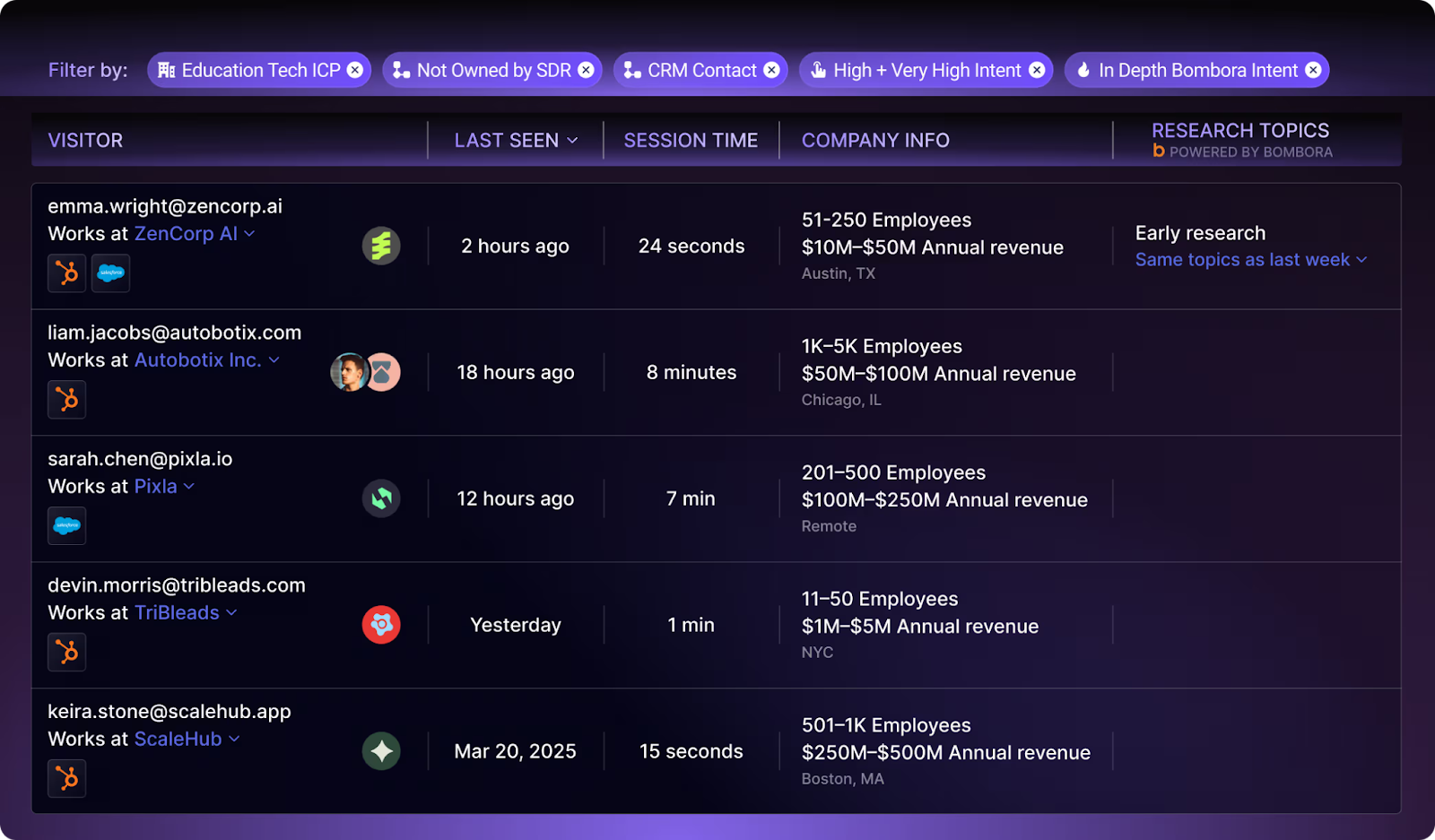
Warmly is an AI-powered sales and marketing platform that states they use artificial intelligence to identify website visitors and automates outreach via platforms like LinkedIn and Outreach to keep leads engaged and moving through the funnel. Built to help SMBs accelerate growth, Warmly offers agentic AI solutions for demand generation, marketing ops, and sales development.
Warmly Features:
Warmly Pricing: Warmly starts at $19,000 per year for 10,000 warm leads per month. The company also offers 25,000 warm leads per month for $25,000/year, 50,000 warm leads per month for $35,000/year, and 75,000 warm leads per month for $45,000/year.
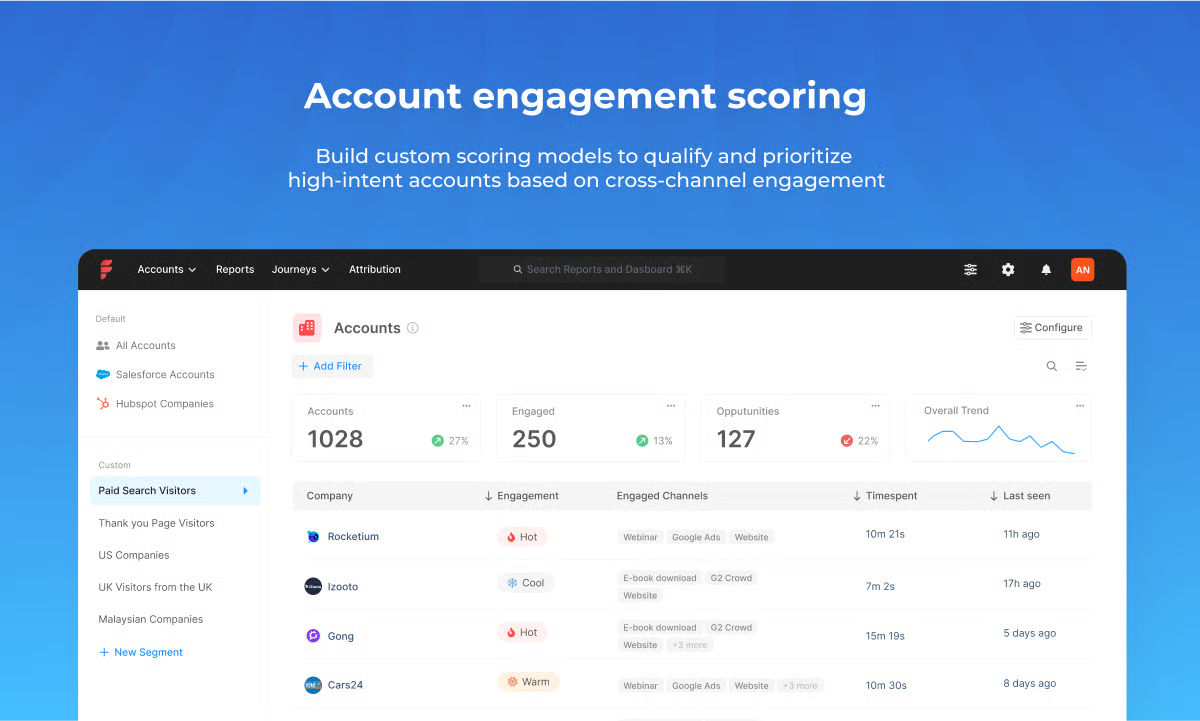
Factors is a demand generation platform powered by agentic AI designed to help sales teams identify high-intent accounts while enriching CRM data and automating outreach. Offering subscription tiers that cater to every stage of a business, from small startups to large enterprises, Factors helps sales and marketing teams learn more about their customers while accelerating lead generation.
Factors Features:
Factors Pricing: Factors offers a free tier that enables you to identify up to 200 companies per month. The company also offers three premium tiers — Basic, Growth, and Enterprise — but pricing information isn’t publicly available.
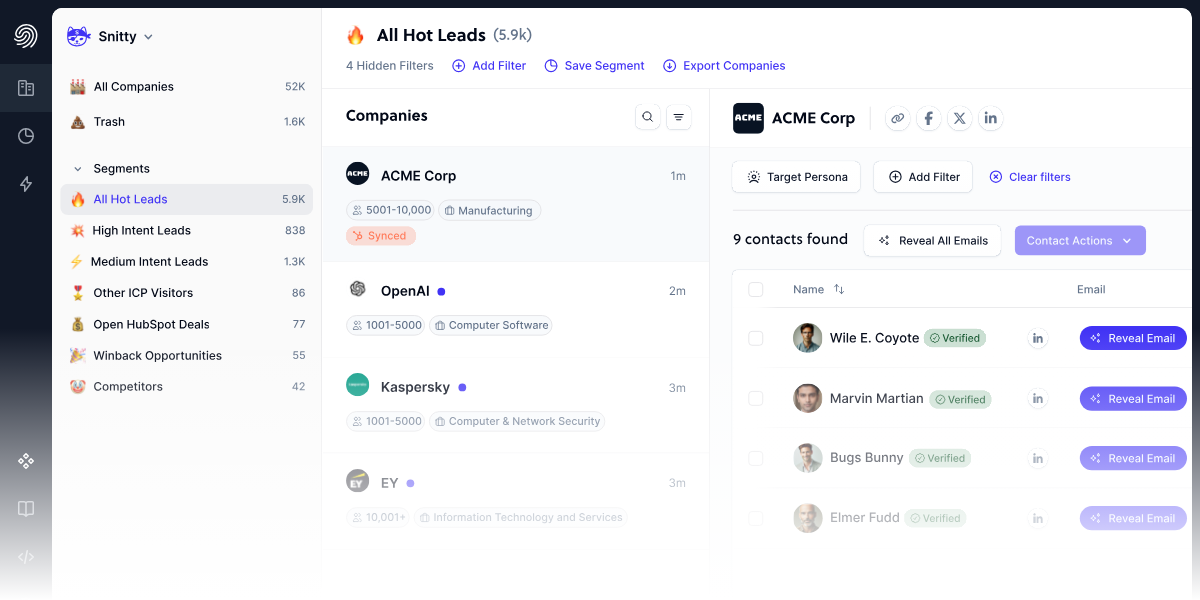
Snitcher is a website visitor identification platform that helps businesses see who visits their sites, converting high-intent users into warm leads. Founded in 2015 in the Netherlands, Snitcher offers a deep integration with Google Analytics, which enables you to retroactively unmask historical website visitors and uncover the path they took to find you.
Snitcher Features:
Snitcher Pricing: Snitcher lets you trial the full platform free for two weeks. After that, the platform is available for $69/month when billed monthly and $49/month when billed annually.
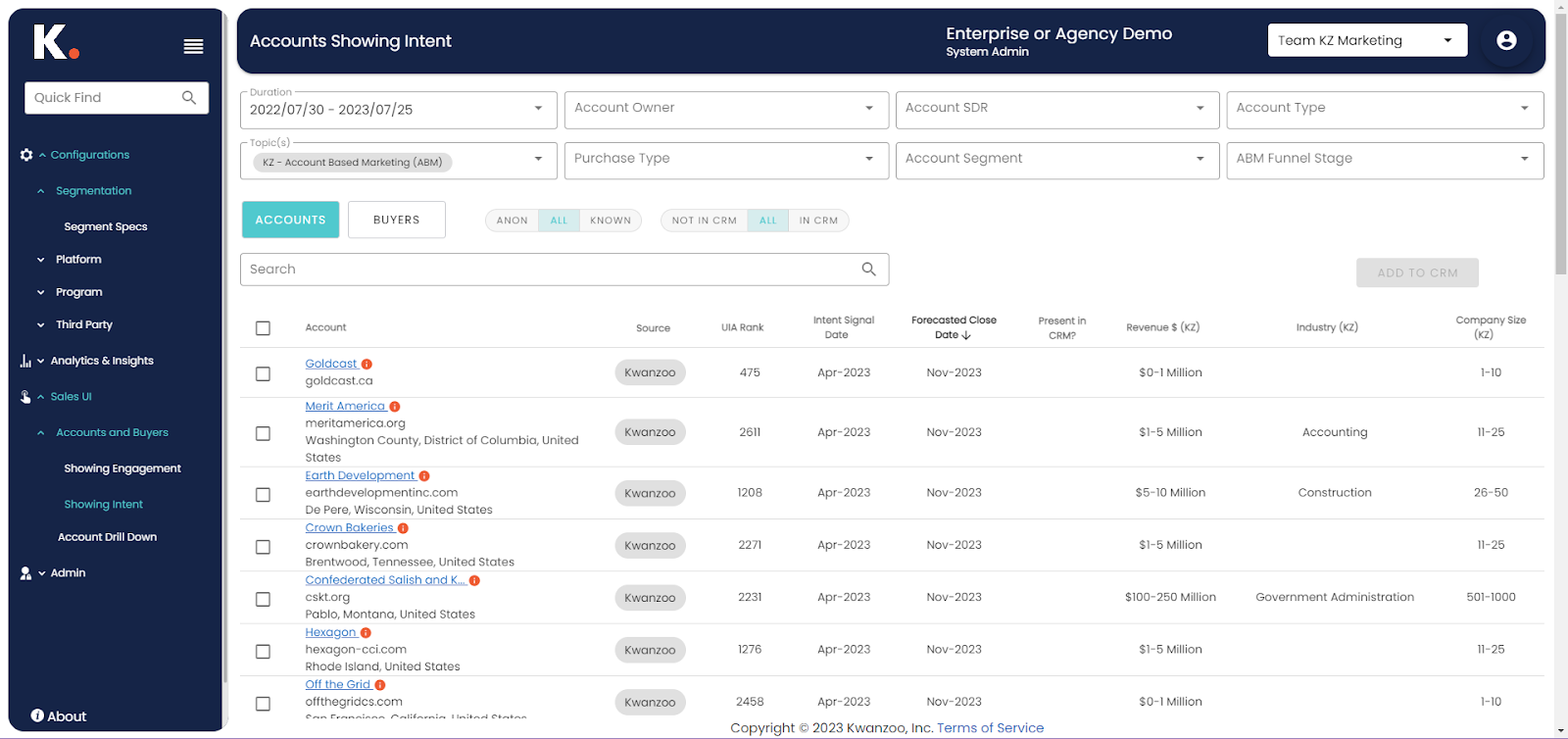
Kwanzoo is an AI-powered GTM automation platform that deanonymizes website visitors from the United States and helps reps spend time targeting accounts most likely to convert and, more specifically, the right people within those accounts. Founded in 2015, Kwanzoo is built for SMBs, mid-market, and enterprise customers in the tech sector (e.g., SaaS, AI, and IT services).
Kwanzoo Features:
Kwanzoo Pricing: Kwanzoo offers a 14-day free trial with 500 credits. The company also offers JumpStart, a $500 flat-fee plan with 750 credits you can use within a year along with three tiers: Start-Up ($250/month; 350 credits/month), Growth ($500/month; 750 credits/month), and Scale-Up ($1,500/month; 1,500 credits/month).
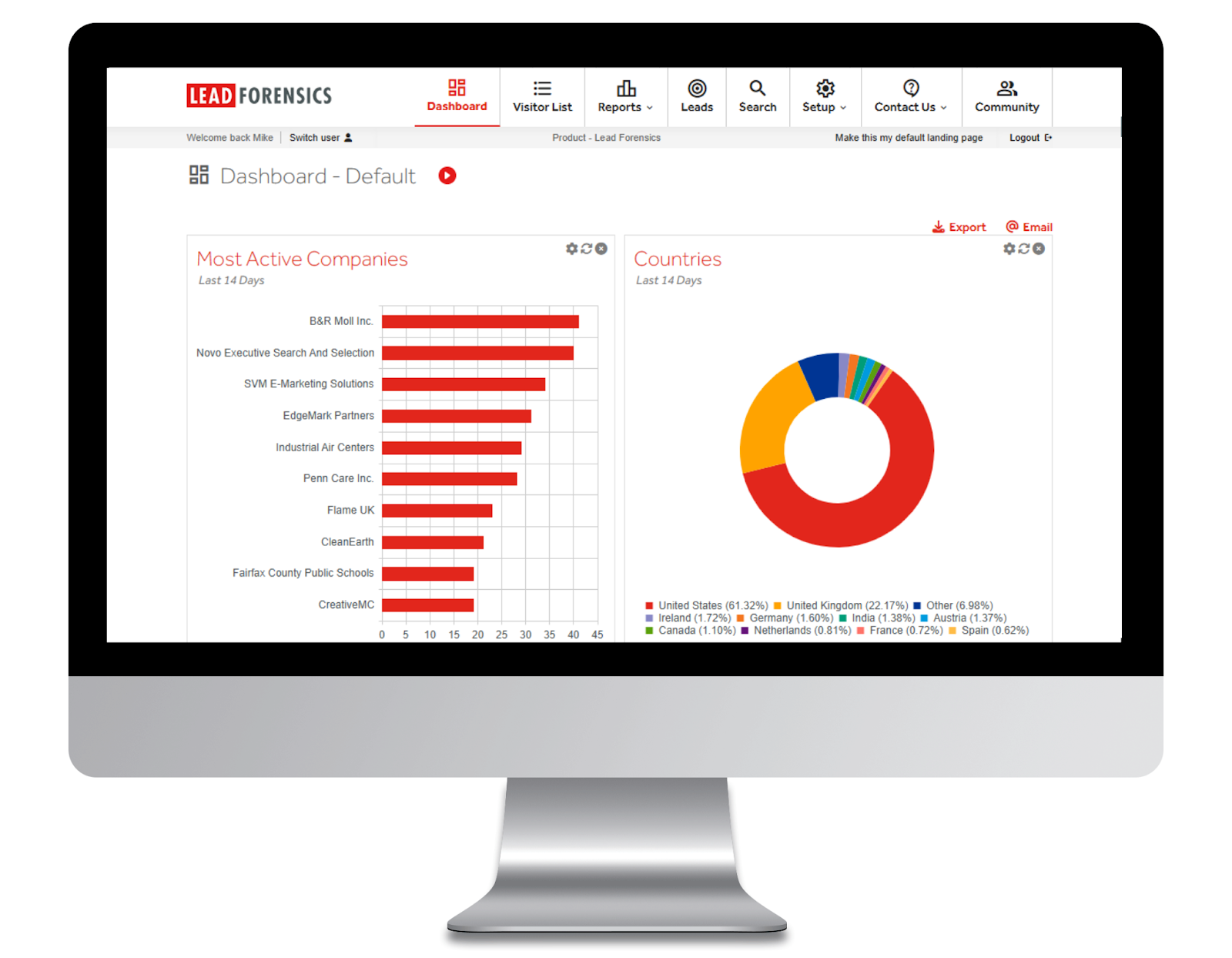
Lead Forensics is a website deanonymizer solution that transforms unknown website visitors into sales-ready leads. The company, which was founded in 2009 and is headquartered in London, delivers contact details for key decision-makers, automatically enriched with firmographic data, which enables teams to transform passively interested buyers into warm pipeline.
Features:
Warmly Pricing: Lead Forensics offers two plans: Essential (for SMBs) and Automate (for enterprises). Unfortunately, pricing data isn’t publicly available.
Adopting technology like RB2B can help your sales team crush its numbers by giving reps a steady stream of high-quality leads who are actively interested in what you’re selling. But when it comes to implementing any kind of technology, it’s important to do your due diligence to make sure you’re choosing that solution that works best for your unique requirements.
As you begin testing RB2B and RB2B alternatives (tests should be free by the way!), follow these steps, including a walkthrough of the data testing process, to increase the chances you end up with a platform that truly moves the needle.
Before you begin testing RB2B or an alternative deanonymization tool, clearly define your goals and how they tie into specific campaigns, like direct outreach sequences or long-term nurture campaigns.
After a website visitor has been identified, what are you going to do with the data? Will you send them into a sales cadence? Retarget the visitor with ads? Drop them into a drip campaign? Whatever you decide, come up with measurable benchmarks around metrics like response rates, conversion rates, and influenced pipeline to determine whether the tool is actually driving ROI.
While most visitor identification tools offer the same core features, the difference lies in the details. Once you’ve figured out your goals, create a list of must-have requirements before testing platforms. For example, you might want platforms that integrate with your tech stack (e.g., Slack, Salesforce, and LeadiQ 😎). If you’re looking to sell to customers internationally, you’ll need a platform that can help you identify visitors from outside the United States, too.
Before springing for yet another tool, spend some time examining your existing stack to see if you already have similar functionality at your disposal or whether one of the vendors you’re already using has features you need on their roadmap. The last thing you want is to buy a duplicative tool; you want a solution that truly fills a gap.
After you understand the functionality you need, spend time comparing RB2B and its alternatives to see which platforms meet your needs best, creating a shortlist of two to three vendors to explore on a deeper level. Contact each of them to run a data test so that you can evaluate each tool’s real-world performance before making a decision.
While there are exceptions to every rule, generally speaking, any vendor worth considering will let you run free tests that enable you to deanonymize at least 40 website visitors. Some vendors might let you test even more visitors, and that’s great. But testing at least 40 will give you a good idea of how the platform works and how accurate its data is, even if it might take some time, depending on how much traffic your site gets.
During this stage, keep in mind that you’re not only comparing the accuracy of the provider’s contact data — think company, name, location, and job title — but also the overall percentage of site traffic they’re able to deanonymize. Weigh both the data quality and scale to determine which platform delivers the highest-value leads without flooding your pipeline with noise.
If you don’t feel confident after the first test, ask to run a secondary test. Vendors that are confident in their products shouldn’t have any issues with proving their value a second time, especially if it means winning your business.
Pro tip: While you might be able to run tests without speaking to sales, consider reaching out to each vendor for insights into data quality as well as the company’s overall responsiveness.
While “land and expand” is often thought of as a sales strategy, it can also be a smart way to roll out new technology. Once you’ve made a selection, kick things off with a small pilot program by integrating RB2B or an alternative into an existing marketing workflow to measure its impact and, ideally, generate quick wins. During the pilot, track performance closely and document lessons learned. Use those takeaways to scale adoption across teams.
Of course, if the pilot proves terribly unsuccessful, you can always pull the plug before you’ve reinvented everything or invested tons of time and resources into something that ultimately doesn’t pan out.
You’ve wrapped up your pilot and you’re ready to roll. Not so fast! Spend some time measuring the real impact of the trial before figuring out the next steps.
At this stage, look at key metrics, like the percentage of deanonymized users who engaged, moved down the funnel, and ultimately led to closed deals. Don’t overlook upsells or cross-sells, either, because deanonymization isn’t just for net-new leads.
Using the insights you gain from this step, you can determine whether the tool is driving justifiable value and warrants further investment, along with how you can scale it across your organization.
When it comes to adding any new tool to your tech stack, having a plan is critical. If you jump into it blindly, you risk wasting time and resources while potentially frustrating your employees.
While a website visitor deanonymization tool like RB2B can help you target high-quality prospects with precision at the most opportune times — and close more deals because of it — such tools can’t give you the complete picture on their own.
That’s where having a top B2B lead enrichment platform at your disposal can be a true game-changer.
Here at LeadiQ, we take great pride in our unique approach to sourcing contact data, which gives our customers the data they actually want unlike other providers that focus on quantity over quality. Plus, we verify our data constantly to ensure it’s accurate, giving our users the peace of mind that comes with knowing the data at their disposal is always actionable.
With features like automatic data enrichment and contact tracking capabilities that notify reps the moment champions, power users, and decision makers switch jobs, LeadiQ helps sales teams stay ahead of the curve by maintaining up-to-date contact information and engaging prospects at critical moments.
As an added bonus, if you end up using a tool that can deanonymize users outside of the United States, LeadiQ can help you sell even more effectively overseas with our robust EMEA contact data and localization capabilities.
To learn more about how LeadiQ can help you target the right people with the right message at the right time, request a demo today.